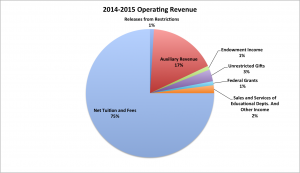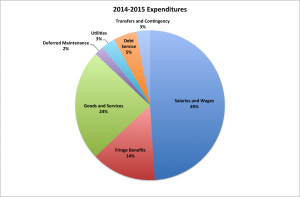Every year student tuition increases between two and four percent at California Lutheran University according to President Chris Kimball. But where does the money go?

Kimball said the total budget is projected to be $104 million for this year, where 75 percent ($78 million) is net tuition and fees.
According to the 2014-2015 budget report, 49 percent ($52 million) of student tuition goes towards salaries and wages, and another 14 percent goes toward fringe benefits.
“Almost exactly half goes to paying people. Faculty, staff, coaches, music teachers, that whole bit,” Kimball said. “And then there is another nearly 14 percent ($14 million) that are benefits for the employees, health insurance, other forms of insurance and retirement plans.”
Another 24 percent ($25 million) goes toward goods and services. Vice President of Enrollment Management and Marketing, Matt Ward, said goods and services are expenses that do not go under personnel.
“It could be travel costs for recruitment, it could be printing publications, buying lab equipment, anything that doesn’t go to the human resource element,” Ward said.
Vice President of Administration and Finance, Karen Davis, said the goods and services section also includes the bookstore, the Sodexo food service and any outside consultance Cal Lutheran uses.
According to the 2014-2015 budget report, 2 percent ($2 million) of the budget is set aside for deferred maintenance. This means if anything breaks or needs to be repaired, Cal Lutheran has the funds to repair it, according to Kimball.
Davis said the university has spent a good amount on renovating existing buildings in the last few years.
“There’s also sidewalk repairs, lighting, classroom upgrades, etc. So every year we spend … We kind of have a minimum of $1.85 per square foot for all of our property,” Davis said.
Rod Gilbert, chair of the Board of Regents, said the tuition increases a variable amount, but there is an increased pressure on expenses because of maintenance for older buildings and utilities.
“We need to increase revenues in the same way,” Gilbert said.
The 3 percent ($3 million) set aside for utilities is a number Cal Lutheran strives to keep low, according to Kimball.
“We have a lot more buildings, but our electricity usage has remained almost the same because, thanks to our facilities people, they’ve really done a lot to be more efficient,” Kimball said.
Five percent ($5 million) is set aside for debt service. Kimball said the university has taken out several loans to be able to pay for buildings and other things, and they have to allocate a certain amount to pay it back.
According to Davis, the university has about $70 million in debt.
There is also 3 percent ($3 million) set aside for transfers and contingency, also known as “our rainy day fund,” according to Kimball.
“[The university] is setting money aside, unbudgeted, in case some emergency happens, and we have something we can have go to,” Kimball said.
Kimball said the school balances the additional cost with what they think the students could afford to pay.
“We don’t cover all of our costs from tuition. So the question is ‘we need X amount, how much can we ask students to cover?”’ Kimball said.
The rest of the operating revenue comes from auxiliary revenue, unrestricted gifts, federal grants, endowment income, sales and services of educational departments and releases from restrictions.
“A lot of that [auxiliary revenue] is room and board. The bookstore is also in there,” Kimball said. “These [other operating revenues] are pieces of money from the endowment, giving, [and] grant money that we get from federal or other sources.”
Release from restrictions means there is money set aside every year for upcoming projects.
“Say, a new building. Once the building is done then that can be released to be used. It’s kind of a catchall category,” Kimball said.
The Board of Regents has to approve any change in student tuition every year.
“What we’re trying to do is to match the revenues and tuition pay with the expenses,” Gilbert said.
Ward said over $40 million are given in institutional aid to students every year, which is equivalent to more than one third of the allocated operating budget. Less than 4 percent of that is funded through donations to the institution.
“We know that affordability is a huge issue, and so it’s always that balancing act of making sure that we’re making the campus accessible,” Ward said.
Gilbert said he sees the tuition increases as value proposition.
“I recognize that it’s a lot to pay, but I also think the value of the Cal Lutheran education has increased substantially. I think our academic profile continues to rise,” Gilbert said.
Rikke Bovre
News and Managing Editor
Published March 4th, 2015


